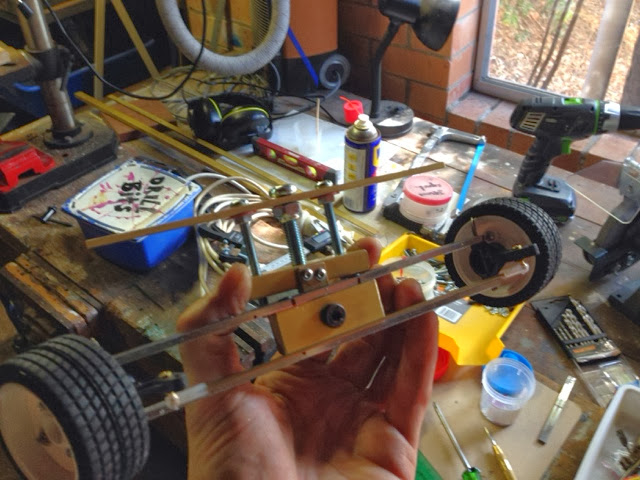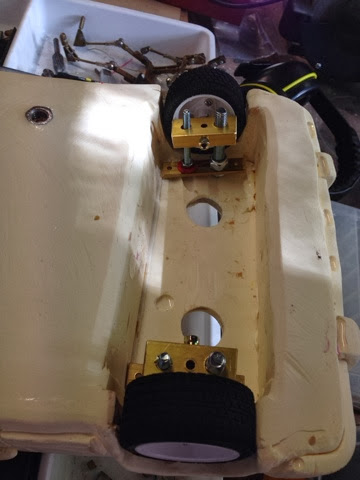Hope it helps.
Remember, budget is the key. (Otherwise you'd buy a DEDO kit!)
Disclaimer: This post contains a log of my experiences and involves some minor home handyman electrical wiring. Please check all facts and use this advice with discretion. I take no responsibility for any damage or injury caused by wiring undertaken as a result of you reading this post.
I'm guessing budget is of the utmost importance, so I'll take that angle...
- If nothing else, use Halogen globed lights. They give the purest white light and as they are a halogen gas, they are a more consistent light than fluro or tungsten, (which flicker if your shutter speed is less than double the frequency of the electricity. eg: (from memory :( in Aus, the freq is 24hz, so you need a shutter speed of at least 48/100ths of a sec, which is pretty long, but managable otherwise you get inconsistencies in your lighting causing flicker. In stopmotion pro and dragon stopmotion there is a frame averaging function which can help with this.)
- Fluros are OK, but if using flouro lights, the light will be greenish, and you'll need a corrector gel over the light. These are good for fill lighting as they are pretty non-directional. LEDs are also greenish, but not as bad. (Both of these generate minimal heat.)
- Tungsten lights will give a yellow tinge and get hot, but not as hot as halogen. I managed to find some reflector tungsten globes in Woolies for about $3 each, which I use in the IKEA lights below...
- For practical lights, you can use xmas lights, but try to use LEDs (that dont blink!)
- Desk lamps are OK, as they can be directed, but once again use halogen bulbs if possible. (I have a bunch of clip on IKEA reading lights which were $5 each, but are plastic, so are limited to globe heat. I use them to spill over harsh shadow edges.)
- Keep in mind Halogen lights get hotter, so many desk lamps will only be able to cope with dim bulbs. OK for Noir, but not for bright and cheerful.
- Also you can't flag the light with cheap materials, well you can, but not from as close! If you can put your hand between the flag and the light, it wont catch fire!
- My best suggestion is to go to bunnings prepared to spend about $50-70, and buy some downlight kits. $12 for a transformer with a wall plug, $18 for a kit with a transformer and lights. They are Halogen, flicker friendly and cheap. (You'll need to wire them yourself, but there are two wires in and only 2 holes. It doesn't matter if you go reverse polarity, as they are 12v. Buy the ones with wall cable attached as theres no 240v wiring for you then, and much safer.
- Think of what you need in terms of number and brightness of lights and then when you get to bunnings, you can consider running many lights off one transformer. The transformers are rated in wattage, where the (number)W = max light wattage. eg: if you get a 120w transformer, you can use as many globes as needed up to the rating of the transformer. so 40w + 40w + 20w + 10w + 10w = 120w, or 40w + 40w + 40w =120w, etc. You need to build a breaker box, where there are powerpoints wired to the transformer. (I have a box with a 120W transformer leading to 2 double points, and an 80w leading to a single powerpoint and dimmer switch. (Also handy!) if dimming, make sure you get a transformer which is rated for dimming. It'slisted on the box, but may cost $10 more. Keep in mind that the transformers are designed to sit within 1m of the light and use a particular wire, so the light my be dimmer than expected if the distance and resistance is longer and greater than designed. Avoid really thin wire, as it is a higher risk of burning out, catching fire and providing inconsistent results. Have a look at the Wiring on the saddles, and that's the minimum you should use. I think the kits have pretty good instructions from memory.)
- For an inline dimmer, you can buy an extension cord from IKEA that has a dimmer in-line for $12. Just plug the light into the dimmer, which is a slider, so you can animate light if needed.
- The globe saddles are only $10 for 6, so you need to wire these into the transformer, either by a 3 pin plug, or straight into the transformer if you don't go with a breaker box. (I actually re-wired these saddles into some desklamps, as the wiring is there!)
- I found that Reverse garbage in Woolloongabba and Absoe in Westend have great used lights, wiring and general awesome stuff for a good price. Keep in mind the transformers are shielded and not grounded, so if using metal light rigs, you may need to ground the light. I get a nice 'Buzz' from one of my lights! I got lots of my light rigs from these places, but be creative and consider sliding clamps, clip on clamps, which you can screw things to and get cheap at bunnings.
- For cutters, cookies and flags, try to use robust materials, like MDF. Polystyrene is good for bounce light, but not for cutters, as it goes up in flames easily. Paint your cutters black so light doesn't bounce and give you lens flare, etc. To hold these up, the sliding clamps are good once again. My kit has about 20 G-Clamps, 10 Slide clamps (diff sizes) a few Magic arms ($$$), misc made to spec weird bits of rigging metals, etc. and I've painted the back wall white for a bounce. I cover that if I don't want bounce. Prior to that, I had a 180x120cm piece of MDF for bounce.
I can't think of anything off the top of my head, but if you can think of any other things I forgot to mention, please email me back. I have some pics of this stuff, but not right now, so I'll email them tomorrow from work, and photograph what I don't have available when I get a sec.
If you'd like to check out the lighting differences, check out my short 'my chair', which I shot the middle (build) section on the IKEA clip-on tungsten reflector globes, then built the breakout box for the first and third acts (the indoor ones.) I think I used some warm gels on the lights for this, but the garage sequence is really harsh.
Sorry for the low res!
Cheers Jason


.jpg)











.jpg)






